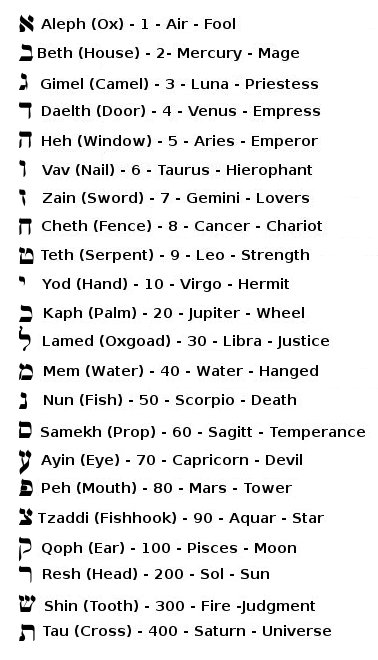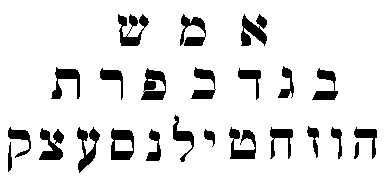
Introduction to the Hebrew Alphabet
by Aaron Leitch

In order to understand the Western Hermetic tradition, it will be necessary to understand the use of Biblical Hebrew as a mystical language. This does not mean it is necessary to speak or read fluent Hebrew. However, you will be working extensively with the letters of the alphabet (or Aleph-Beth), and certain words and phrases in Hebrew will become as familiar to you as any word in your native tongue.
If the student questions why we should bother with Hebrew as a "sacred language", it is my hope to fully answer the question in this lesson. As we shall see, the Hebrew alphabet was the first true alphabet among humankind. Each letter encompasses hieroglyphic, phonetic, and numerical values.
Hebrew also enjoyed the honored status of "dead language" for thousands of years- including the time during which the Western Hermetic traditions were born. This, combined with the fact that the Old Testament was written in Hebrew, made the Semitic language the choice par excellence for Medieval and Renaissance mysticism. (Both Judaic and Christian.) Once established as a sacred language, the letters earned even further correspondences and interpretations- many of which we will cover below. By the time of the Middle Ages, Hebrew was understood to be the true language of the Angels. (Western occultism would not challenge this assumption until John Dee received his Angelic Language in 1583.)
A Jewish Legend: The Alphabet
When God was about to create the world by His word, the twenty two letters of the alphabet descended from the terrible and august crown of God whereon they were engraved with a pen of flaming fire. They stood round about God, and one after the other spake and entreated, “Create the world through me!”
After the claims of all the letters had been disposed of, Beth stepped before the Holy One, blessed be He, and pleaded before Him: “O Lord of the world! May it be Thy will to create Thy world through me, seeing that all the dwellers of the world give praise daily unto Thee through me, as it is said, 'Blessed be the Lord forever. Amen, and Amen.'” The Holy One, blessed be He, at once granted the petition of Beth. He said, “Blessed be he that cometh in the name of the Lord.” And He created His world through Beth, as it is said, “Berashith (In the Beginning) God created the Heaven and the Earth.”
The only letter that had refrained from urging its claims was the modest Aleph, and God rewarded it later for its humility by giving it the first place in the Decalogue.
[Legends of the Bible by Louis Ginzberg]
The oldest forms of written communication on our planet are called Cuneiform (Kew-nay-ih-form) and Hieroglyphics (Hi-row-glif-iks). Cuneiform is a wedge-shaped lettering from Mesopotamia that was impressed into wet clay tablets and then baked after the manner of bricks. It was an incredibly cumbersome, yet durable method of recording information. Hieroglyphics, as you likely know, are small pictograms from Egypt that were painted on sheets of papyrus paper with simple paints. This was a very convenient but non-durable method of recording information.
Yet, each of these languages held one thing in common- they were both primarily what we call "hieroglyphic." This means that each character of these written languages were intended to convey an entire word (or more!), rather than representing a phonetic sound.
When we refer to an "alphabet" we are specifically indicating a series of characters with phonetic values, which must be compiled to form words. Not so with Egyptian and Mesopotamian writing. For them, each word had to have its own picture. Most primitively (especially with Egyptian), each character was literally a simple pictogram of the object it represented. More complex ideas could then be formed by compiling several pictograms. Over time, these pictograms became more and more stylized (simplified)- until we see languages like Cuneiform that look more like letters than hieroglyphs. Yet, as more and more words were created, even the stylized character sets became huge and cumbersome. Something better had to come along.
It was at this point that actual alphabets came into fashion. Somewhere in Palestine in about 1500 BCE some folks began to assign phonetic values to their hieroglyphs. It was really a simple matter. The little pictograms already represented whole words. Therefore, each one could just as easily stand for the sound of the first letter of its word. For instance, the Semitic name for an ox was "Aleph"- and so the hieroglyph for Aleph became the character for the sound of "A." The Semitic name for a tent or dwelling was "Beth"- and so the hieroglyph for Beth became the character for the sound of "B." This process continued until a series of 22 pictograms had been chosen to represent 22 essential sounds in the spoken language.
The earliest examples of this new alphabetic writing come from the area of Palestine known as Phoenicia- or Canaan in Biblical literature. The alphabet is sometimes called by the term "Paleo-Hebrew" (that is "ancient" Hebrew) and sometimes by the term "Ugaritic" after the name of the Canaanite city where the earliest such writings were found.

Ugaritic script is something of a combination of the hieroglyphs of Egypt and the Cuneiform of Sumeria and Babylonia. As indicated previously, each letter in the alphabet still represents an entire word all by itself, and thus retains its hieroglyphic value. Yet the appearance of the letters lends itself better to Cuneiform-style impression on clay tablets- and this is exactly how they were found in Ugarit. (This pan-Egypto-Mesopotamian influence is found throughout ancient Palestinian culture.) Finally, each letter also represents a single phonetic sound, therefore allowing (for the first time in history) any number of words to be "compiled" from the available sounds in the alphabet.
During this period of Middle Eastern history, there was very little distinction between the people of Canaan and Israel. While Biblical tradition proclaims them- and their Gods Yahweh and Baal- as bitter rivals, the historical evidence indicates the two cultures were actually very similar. Of course, there were some essential differences based upon geography. The Canaanites were primarily a seafaring people who lived on the coast, while the Israelites were mainly pastoral and lived in Palestine's interior regions. However, the common people of both nations intermixed quite freely, sharing between them language, religion and culture.
In this way the Ugaritic alphabet made its way from Canaan to Israel- where it became the proper ancestor of Hebrew- "Paleo-Hebrew." The Hebrew language we know today was originally a dialect of Canaanite. Of course, the Israelites made the alphabet their own over time. In about 400 BCE, scribes writing in Aramaic (a Mesopotamian language adopted by the Israelites during the Captivity in Babylon) abandoned the clay tablet method in favor of the more Egyptian practice of painting the letters on papyrus and parchment. When the Hebrew language was painted in this way, it created the "brush-stroke" style with which we are most familiar today- called "Aramaic" or "Square-Script" Hebrew. It is also commonly referred to as "Biblical Hebrew"- so called because this was the alphabet used to scribe the Old Testament and other ancient Biblical texts.

Unlike later versions of the Hebrew tongue, Biblical Hebrew possessed no vowels. (Later versions adopted "vowel points" instead of adding new letters. These were small markings written alongside the Hebrew letters to indicate which vowel sounds should be spoken when the text was read aloud.) Because vowels are lacking in ancient texts, we are left with little to no clue as to how Biblical Hebrew may have really sounded.
For instance, take the word SPhR (Samekh, Peh, Resh)- the base of the word Sephirah. We can not know if this was pronounced "Sephar", "Sepher", "Siphur", or any number of other phonetic possibilities. This is complicated by the fact that all three of these examples indicates a different Hebrew word! (Sephar = Count, Sepher = Book, Siphur = Speak.) For this reason, the study and use of Biblical Hebrew is an inexact science at best.
Of course, this was not a problem in ancient times, because the student would have learned the language orally from his elders and teachers. It is likely because of this that no one at the time thought about a need for vowels. They appeared obvious to the native Hebrew speaker, and were inferred in writing by context. It is much like our own understanding of the words "read" (I must read that book) and "read" (I have already read that book). We understand the difference because our parents and teachers have taught us by vocal example.
However, we don't have such a luxury where it comes to Biblical Hebrew. The continuity of teaching the language from one generation to the next was shattered in 600 BCE by the Captivity in Babylon. As previously mentioned, this was the period when the Jewish people adopted the common Mesopotamian language of Aramaic- which is known to have both Hebrew and Arabic influences. The scribes created the "Square Script" method of writing Hebrew during this period, but the true pronunciations of the words were rapidly lost forever. Hebrew became the Holy Script of the Tanakh (the Old Testament), but was otherwise a dead language- no longer spoken by common people.
Because Hebrew was used to write the Tanakh, and was assumed to be the language spoken by every Biblical patriarch and prophet, it became strictly reserved for religious and mystical purposes. It was assumed to be the language with which Angels could communicate with humans, and its creation was credited to no one less than Adam himself:
A Jewish Legend: The Ideal Man
The name of the animals were not the only inheritance handed down by Adam to the generations after him, for mankind owes all crafts to him, especially the art of writing, and he was the inventor of all the seventy languages.
[Legends of the Bible by Louis Ginzberg]
Therefore, the Square Hebrew Script became the alphabet of choice for Hebrew mystics and occultists- such as the Baalim Shem (Masters of the Name) and Merkavah Mystics. Hebrew characters are most predominant on Jewish talismans starting in the period of the Captivity, and in Jewish Qabalistic texts of the Medieval and Renaissance eras.
During this same period, the Hebrew script drew the attention of Christian mystics. Previously, the Christian traditions had utilized more late-Egyptian and Greek characters, as their mysteries were based mainly upon the New Testament and its Apocrypha (written largely in Greek, Coptic, and other languages). However, the Jewish traditions surrounding the Old Testament always held a fascination for Christian mystics. Therefore, especially during the Medieval period, the Hermetists and other Christian occultists were quick to adopt Hebrew as a Magickal Alphabet.
It would be another several hundred years before Hebrew returned to the world as a common spoken language. This began in 1881 CE, when Eliezar Ben Yehuda (1858-1922) began promoting the use of Hebrew in schools as well as for everyday use. To accomplish this, it was necessary to drastically update the language- adding thousands of new words and spelling conventions. He founded two Hebrew-language periodicals, and (in 1890 CE) co-founded the Hebrew Language Committee. In 1910 CE, he began work on a 17 volume reference called The Complete Dictionary of Ancient and Modern Hebrew, which was finished by his wife and son in 1959.
The history of the Hebrew character set is nothing short of awe inspiring. It is more than merely ancient- it is downright primordial. It is the first of all alphabets- the original model upon which the Greek and later Latin alphabets were based. Its vital role in the development of Western civilization and religion can not be denied- and this is why it remains a powerful magickal language today.
So far, we have discussed the development of the Hebrew letters as they were used to record words. However, there is even more to the alphabet that makes it so useful as a magickal language.
Like all ancient languages, Hebrew does not possess a separate set of characters to represent numbers. Instead, numerical values were assigned to each letter according to their established order in the alphabet:

At some point, five "extra" letters were added to the list to indicate higher numbers from 500 to 900. These are called "finals", and are actually modified versions of five existing letters. (Kaph, Mem, Nun, Peh and Tzaddi.) The "finals" are used only when these letters fall at the end of a word. I have not included them here because it is unlikely they were used in Biblical Hebrew. Some modern mages choose to use them, while others ignore them. (I personally tend to ignore them.)
Because each letter of the Hebrew alphabet can also stand for a number, it becomes possible to total the letters of any word to receive a numerical sum. For instance, consider the Hebrew word for "Lord": Adonai
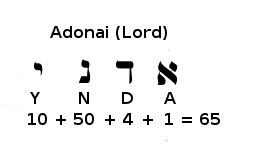
The four letters of Adonai- Aleph, Daleth, Nun and Yod- add together for a total of 65. Normally, we would analyze the number 65 Qabalstically- in a manner similar to numerology. When this is done with Hebrew, it is called Gematria- a practice within the Qabalistic tradition. However, the Qabalah arose much later than Biblical Hebrew. Therefore, I will wait until later lessons to explain those methods.
The Gematria used by the scribes of Paleo-Hebrew and early Biblical Hebrew was simpler and straightforward. Rather than analyzing "65" as a mystical number in its own right, the Hebrew mystic was more interested in finding other Hebrew words that share the value of 65 with Adonai. Those words, it is believed, share some kind of mystical relationship with the name Adonai, and throw light upon its inner spiritual meanings.
To continue the example, I have found two further words in Hebrew with a value of 65. One is Hekel (Heh, Yod, Kaph, Lamed), which translates as Temple or Palace. Another is Has (Heh, Samekh), translating as Silence. (There is some indication that Has indicates a command to be silent.)
The Hebrew mystic would meditate long upon these three words: Lord, Temple, and Silence. He would ask how these things are related, and what they tell him about each other. He might assume that this means Silence is always required in the Temple of the Lord. If he thinks deeper, he might realize that Silence IS the Lord's Temple. ("He who works in Silence, and naught but Silence can express!") There are other possible interpretations as well- each of them relevant to the mystic who discovers them.
This might seem like a leap in logic (or faith) to us, but it wouldn't have seemed very strange to an ancient scribe. Biblical Hebrew, like all primitive languages, possesses extremely loose word definitions. Our modern languages must be precise and intricate, or else our sophisticated technology would be impossible. This was not the case in early historical times, and it left the writer with a large amount of creative license in how he used his words. For instance, the Hebrew word Yetzirah does not merely translate as “Formation.” In fact, it might indicate any number of related concepts: Formation, Creation, Construction, etc.
At the same time, there was no such thing as standardization for spelling or writing at the time. This gave the writer even more creative license, and led to large overlaps in words that were spelled or sounded phonetically similar. The concept of “punning”- today considered a kind of humor- was taken very seriously by ancient bards, scribes and priests. It seems to be mankind's first realization that words and texts might have multiple interpretations.
We might say, then, that “punning” was the very birth of Gematria- words related to other words in mysterious ways. Number-based Gematria would have been a natural progression from there. Especially when we consider how mystical the ancient priest-scribe considered mathematics in general.
The student should practice with this technique while learning Hebrew and the Qabalah. I suggest obtaining a copy of Godwin's Cabalistic Encyclopedia. It contains most of the Hebrew words you will encounter in Western magick, along with their numerical sums. Further, it provides two separate sections of words grouped together according to their numbers.
At the same time, the student may also find a Hebrew Lexicon very useful- and these can be purchased online or in any bookstore. They don't contain the numerical values of the words, but they will provide all of the Hebrew not included in Godwin's work.
The Sepher Yetzirah (Book of Formation) seems to have appeared in the early Common Era, somewhere between the first and third centuries. Its subject is the formation of the universe through the powers of the 22 letters of the Hebrew Alphabet. In this view, each letter is considered a spiritual force in its own right. By re-arranging and combining them in various patterns, God accomplishes the creation of the entire cosmos of space, time, and spirit.
From the Sepher Yetzirah:
1:2 Twenty-two are the Letters, the Foundation of all things; there are Three Mothers, Seven Double and Twelve Simple letters.
2:2 He hath formed, weighed, and composed with these twenty-two letters every created thing, and the form of everything which shall hereafter be.
The major innovation to the Hebrew alphabet granted by the Sepher Yetzirah is the categorization of the letters into three mystical groups. These are primarily astrological- so that 3 of the letters are assigned the principal Elemental forces (Fire, Water, and Air), 7 are assigned the classical Planets, and the remaining 12 letters are given the signs of the Zodiac. These are called the Mother, Double, and Simple letters respectively.
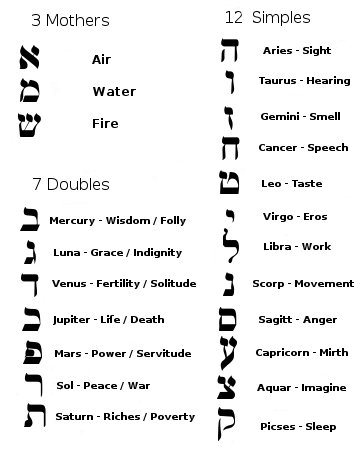
The 3 Mother Letters in Sepher Yetzirah:
2:1 The twenty-two sounds and letters are the Foundation of all things. Three mothers, seven doubles and twelve simples. The Three Mothers are Aleph, Mem and Shin, they are Air, Water and Fire. Water is silent, Fire is sibilant, and Air derived from the Spirit is as the tongue of a balance standing between these contraries which are in equilibrium, reconciling and mediating between them.
3:2 The Three Mothers, Aleph, Mem and Shin, are a great Mystery, very admirable and most recondite, and sealed as with six rings; and from them proceed Air, Fire, and Water, which divide into active and passive forces. The Three Mothers, Aleph, Mem and Shin, are the Foundation, from them spring three Fathers, and from these have proceeded all things that are in the world.
3:3 The Three Mothers in the world are Aleph, Mem and Shin: the heavens were produced from Fire; the earth from the Water; and the Air from the Spirit is as a reconciler between the Fire and the Water.
The three Mother Letters are the primary forces in the universe- representing the Heavenly Fire, the Waters of the Abyss, and the Air (or Spirit) of God that moved upon the face of the Waters. (See Genesis 1.) The Water and the Fire are the polar opposites of the cosmos, and the Air is the reconciling force between them. They are the Thesis, Antithesis, and Synthesis that compose all things in created reality. As such, it is from the 3 Mothers that the other forces of the universe are born.
The 7 Double Letters in Sepher Yetzirah:
4:1 The Seven double letters, Beth, Gimel, Daleth, Kaph, Peh, Resh, and Tau have each two sounds associated with them. They are referred to Life, Peace, Wisdom, Riches, Grace, Fertility and Power. The two sounds of each letter are the hard and the soft--the aspirated and the softened. They are called Double, because each letter presents a contrast or permutation; thus Life and Death; Peace and War; Wisdom and Folly; Riches and Poverty; Grace and Indignation; Fertility and Solitude; Power and Servitude.
4:3 These Seven Double Letters He designed, produced, and combined, and formed with them the Planets of this World, the Days of the Week, and the Gates of the soul (the orifices of perception) in Man. From these Seven He bath produced the Seven Heavens, the Seven Earths, the Seven Sabbaths: for this cause He has loved and blessed the number Seven more than all things under Heaven (His Throne).
The seven Double Letters are so-called because they each represent two distinct sounds in Hebrew pronunciation. These are called "hard" and "soft" sounds- though I know of no established rules for when one sound should be used instead of another. It seems to depend on the word and which dialect of Hebrew one wishes to speak. Here are the seven letters and their dual sounds:
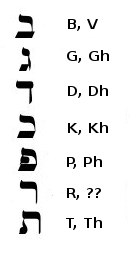
This group, as described in the Book of Formation, is associated with every instance of the sacred number 7 in Biblical tradition. Seven Days of Creation, seven Heavens, seven Hells, etc.
Most importantly for our purposes, they represent the powers of the Seven classical Planets: Saturn, Jupiter, Mars, Sol, Venus, Mercury, and Luna. Just as each Planetary force possesses an Exalted and a Detrimental aspect, so too do the seven Double Letters represent dual aspects of life here on Earth. Every positive naturally brings forth its negative- so that Life naturally brings about Death, Wisdom defines Folly, Riches cause Poverty, etc. One is intended to meditate upon each Double Letter- contemplaing how the opposites assigned to it are two sides of a single coin.
The 12 Simple Letters in Sepher Yetzirah:
5:1 The Twelve Simple Letters are Héh, Vau, Zain, Cheth, Teth, Yod, Lamed, Nun, Samech, Ayin, Tzaddi and Qoph; they are the foundations of these twelve properties: Sight, Hearing, Smell, Speech, Taste, Sexual Love, Work, Movement, Anger, Mirth, Imagination, and Sleep.
5:2 These Twelve Simple Letters He designed, and combined, and formed with them the Twelve celestial constellations of the Zodiac, whose signs are Teth, Shin, Tau, Samech, Aleph, Beth, Mem, Oin, Qoph, Gimel, Daleth, and Daleth. The Twelve are also the Months of the Year: Nisan, Yiar, Sivan, Tamuz, Ab, Elul, Tishri, Hesvan, Kislev, Tebet, Sabat and Adar. The Twelve are also the Twelve organs of living creatures: the two hands, the two feet, the two kidneys, the spleen, the liver, the gall, private parts, stomach and intestines.
The final 12 letters of the Hebrew alphabet relate to all instances of the sacred number 12 in Biblical tradition. Remember there were twelve Tribes of Israel- probably themselves based upon the constellations of the Zodiac.
It is obvious that astrology is the bases of the above division of 22 Hebrew letters. When an astrologer casts a horoscope, he is attempting to "read" the stars to learn what to expect here in manifest reality. Because God is the "Prime Mover" behind the motions of the stars and planets, He becomes something of an author writing the story of the World in an alphabet of stars. By combining these "celestial letters" in different patterns (as shown in the horoscope), God gives birth to infinite created things- just as combining alphabetic letters in different patterns gives birth to infinite words and ideas.
Qabalistic tradition holds that Adam understood this Celestial Alphabet, but lost much of it when he fell from Paradise. The Hebrew Alphabet was then created by Adam as an earthly reflection of that perfect Celestial Alphabet. Hence the 3, 7 and 12 astrological division of the letters.
In the Western Hermetic traditions, we are most concerned with these astrological correspondences for the Hebrew letters. The Elements, Planets, and Zodiacal Signs are the forces we regularly invoke in our mysticism and magick. Because they are all associated with Hebrew Letters, it allows us to draw the Hebrew language into our practice of talismanic magick. (This subject will be covered in greater detail in more advanced lessons.)
The Sepher Yetzirah tells us that the 22 Hebrew letters are attributed to the 22 Paths of the Tree of Life. We have already discussed this subject to some extent in the "Introduction to the Tree of Life" lessons. The energies that flow between the ten Sephiroth move along twenty-two pathways that represent- like the 22 Letters- the cyclic forces of the manifest universe. Modern systems tend to attribute the 22 Major Arcana cards of the Tarot to these paths, and thus by extension to the Hebrew letters as well. Taking all of this together- the Path, Letter, Astrology, and Tarot- gives us a rather complete system of philosophical symbolism. It encompasses several interrelated occult practices, and is the heart of modern Western Hermeticism.
I also mentioned in the "Introduction to the Tree of Life" that different mystical systems assign the Letters to the Tree's pathways in different patterns. It is tempting to try and rank one as "better" than another. However, as the Sepher Yetzirah stresses, the Letters are actually intended to be mixed and combined in different patterns for different purposes. Because the pathways are active and dynamic (as opposed to the passive and receptive Sephiroth), one should find a different arrangement each time one views the Tree. (Similar to the shuffling of the Tarot deck before the cards are laid out for interpretation.) Therefore, each unique system of 22 Paths is correct in illustrating the point it intends to illustrate.
The version you will likely encounter the most comes to us from the Hermetic Order of the Golden Dawn. They borrowed it from the work of Eliphas Levi- whose published writings were a big influence on the early Adepts of the Order. Levi had suggested that the Hebrew Alphabet should run in perfect order from Aleph at the first Path (extending from Kether) to Tau at the very last (touching Malkuth). Following is an illustration of this arrangement:

Notice that the first Path (associated with Aleph) is numbered 11. This is because the first ten Paths- as outlined by the Sepher Yetzirah- are the ten Sephiroth. Therefore, the first Path is actually numbered 11, and the last Path (associated with Tau) is 32. If this is confusing, you can always just subtract ten from the path number.
This illustrates a natural flow of energy downward through the Tree of Life. Especially when we bring the Tarot Trumps into the interpretation, we can see an evolutionary process (spiritual and physical) from the first and most spiritual Path (the Fool Card) to the final and most material Path (the Universe Card).
On the other hand, the Sepher Yetzirah itself outlines a very different version of the 22 Paths. Not surprisingly, this version is based entirely on the 3, 7, 12 division of the Letters we have already discussed. Curiously, the Paths on the Tree already possess a similar division. There happen to be exactly three horizontal Paths, seven vertical Paths, and twelve diagonal Paths!
Therefore, the Book of Formation assigns the 3 Mother Letters to the horizontal paths- Shin to the highest Path (the Fire above), Mem to the lowest (the Water below), and Aleph between them (the reconciling Air). The 7 Double Letters are arranged across the seven vertical Paths, forming the Three Pillars we have discussed in previous lessons. Finally, the 12 Simple Letters make up the diagonal Pathways, taking energy across from one Pillar to another. Below is an illustration of this arrangement:
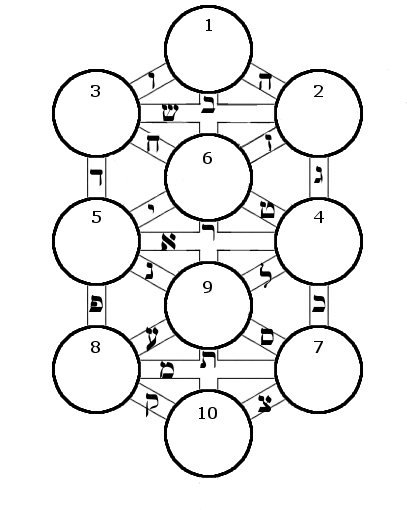
This concludes the Introduction to the Hebrew Alphabet. In order to understand the more advanced lessons on Gematria, Talismanic Imaging, and practical magick, it will be necessary to commit the Hebrew Alphabet and its correspondences to memory. For convenience, I have included below a comprehensive list of the Hebrew Letters and their various correspondences- name and translation, number, astrological force, and Tarot. This can be printed out for study and practical reference:
